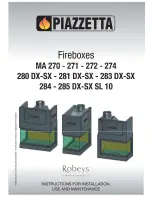
22
ELEVATED VERTICAL RISE THROUGH-THE-WALL VENTING
The required MINIMUM vertical rise is 48 in. when used with a maximum horizontal run of 12 ft. For other venting configu-
rations within these maximum limits, see Figure 6, PG. 18.
NOTE: All horizontal runs of vent pipe must be level or have a ¼" rise for every 1' of run toward the termination.
Never allow the vent to run downward. This will cause high temperatures and the possibility of a fire.
USING OFFSETS AND RETURNS
: A single 90
º
vertical-to-horizontal elbow is already calculated into the allowable max-
imum 12' horizontal run. Each additional 90
º
elbow reduces the maximum horizontal distance by 3'. Example: by using
three total 90
º
elbows the maximum horizontal distance has been reduced to 6 ft. (3 - 1 = 2 elbows x 3' = 6'; 12’ Max. - 6'
of elbows = 6' of horizontal run). Note: 45
º
elbows reduce the maximum horizontal distance by 1½ '.
SUPPORT
: Horizontal runs of pipe will require one vent support for every 3 ft. of pipe.
CAUTION
: If a vertical-to-horizontal elbow is enclosed within a wall, floor or ceiling, a top air space clearance of 3" must
THIS FIREPLACE MUST BE INSTALLED BY A QUALIFIED MENDOTA APPROVED SERVICEPERSON.
be maintained above the elbow. Be sure to maintain 1" air space to any combustibles on the sides and bottom, 3" above
horizontal pipe sections.
1. Position fireplace in desired location. See PG. 13 for guidelines on proper vent cap placement on exterior of
home. Check to determine if wall studs are in the way when vent system is attached. If this is the case you may
want to adjust the fireplace location.
2. Locate the position where vent pipe will pass through any ceilings and will penetrate the outside wall. Since vent
pipe sections "overlap" we suggest pre-assembling and measuring the total vent pipe run so you can more accu-
rately locate the point where the vent pipe will penetrate the outside wall (See Figure 2: Exterior Vent Locations,
PG. 13). Be sure all vent components are properly twist locked and leak-proof. It is recommended that 1000
º
sealant be used in the inner pipe joints of all pipe sections manufactured by Simpson DuraVent.
3. Cut and frame a 9-1/2” wide x 10” high openings in the outside wall openings and 9” x 9” opening in ceiling open-
ings. The outside wall hole must be positioned so the vent system will run level or have a ¼" on rise AND
be per-
pendicular to the wall. The height of the opening must be located to meet all building codes and not allow the
termination to be easily blocked or obstructed. A ceiling fire stop spacer is required at all floor (ceiling) penetra-
tions.
4. Connect vent pipe to the fireplace adapter on top of fireplace vent outlet.
5. The horizontal pipe must end flush with the exterior wall of the home. Horizontal pipes will require proper support
every 3 ft. of vent pipe. THERE MUST BE A MINIMUM OF 1" CLEARANCE TO COMBUSTIBLES ON THE
SIDES AND BOTTOM OF ALL VENT PIECES (3" above horizontal runs and above elbows).
6.
A wall thimble must always be used when penetrating combustible wall materials
.
NOTE: Combustible wall thickness must
7. From the exterior of the home, slide the horizontal vent cap over the end of the horizontal pipe and tightly secure
the vent cap to the wall with screws. Seal with high quality caulking.
be 4" to 8" maximum for the wall thimble. Wall more than 8” thick will re-
quire special protection. Contact Mendota Technical services for assistance.
WARNING
:
Venting terminal shall never be recessed into wall cladding or siding. Vent Cap must sit on top of sid-
ing or cladding.
IMPORTANT: REFER TO DRAWINGS ON PAGES 14-17 WHILE FOLLOWING THESE INSTRUCTIONS.
NOTE: DO NOT SEPARATE TELESCOPING SECTIONS. THEY MUST BE USED AS COMPLETE ASSEMBLIES.
















































